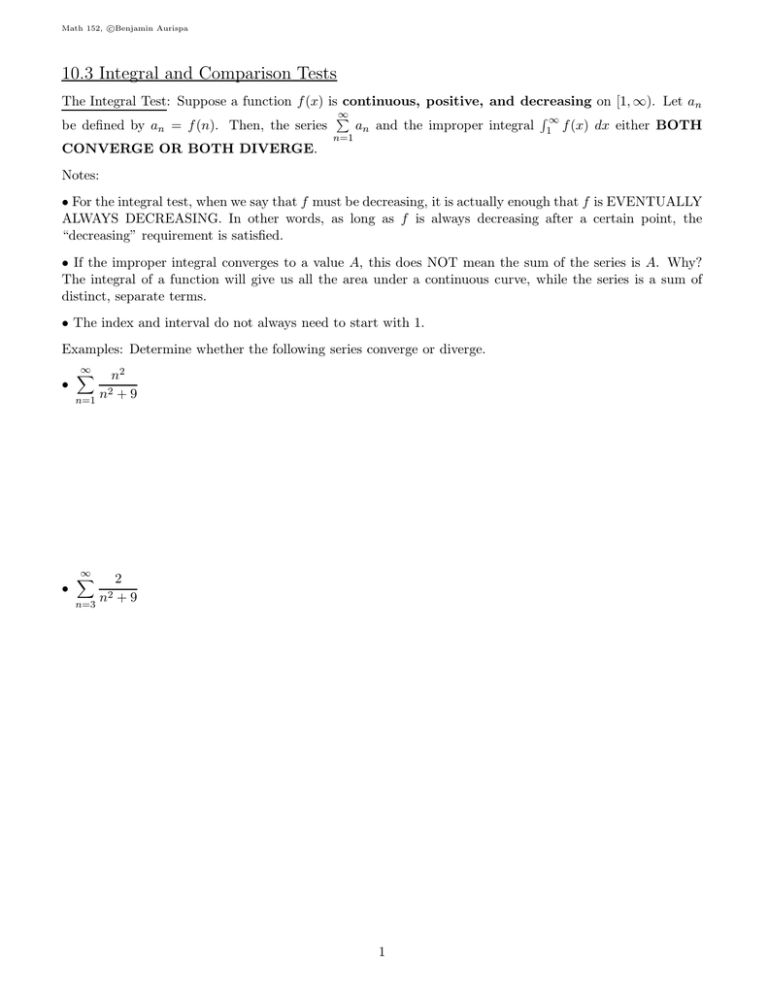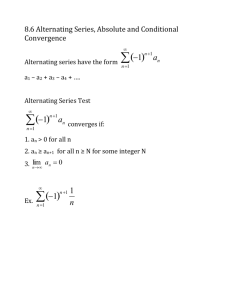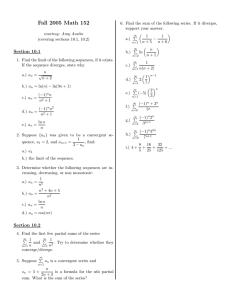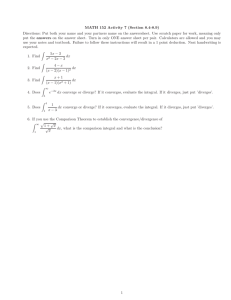Document 10504221
advertisement

c Math 152, Benjamin Aurispa 10.3 Integral and Comparison Tests The Integral Test: Suppose a function f (x) is continuous, positive, and decreasing on [1, ∞). Let an be defined by an = f (n). Then, the series CONVERGE OR BOTH DIVERGE. ∞ P n=1 an and the improper integral R∞ 1 f (x) dx either BOTH Notes: • For the integral test, when we say that f must be decreasing, it is actually enough that f is EVENTUALLY ALWAYS DECREASING. In other words, as long as f is always decreasing after a certain point, the “decreasing” requirement is satisfied. • If the improper integral converges to a value A, this does NOT mean the sum of the series is A. Why? The integral of a function will give us all the area under a continuous curve, while the series is a sum of distinct, separate terms. • The index and interval do not always need to start with 1. Examples: Determine whether the following series converge or diverge. ∞ X • n2 n2 + 9 n=1 • ∞ X 2 2+9 n n=3 1 c Math 152, Benjamin Aurispa ∞ X ln n • n=2 • ∞ X n ne−n 2 n=2 p-series: We saw in Section 8.9 that the integral Z 1 the Integral Test, the p-series ∞ X 1 n=1 Notes: • When p = 1, the series np ∞ 1 dx converges if p > 1 and diverges if p ≤ 1. So, by xp converges if p > 1 and diverges if p ≤ 1. ∞ X 1 is called the harmonic series. n • Any constant multiple of a convergent p-series is also convergent. n=1 Example: • ∞ X 2016 n=1 √ n n 2 c Math 152, Benjamin Aurispa Comparison Test: Suppose ∞ P an and ∞ P bn converges, then n=1 • If an ≤ bn for all n and if n=1 ∞ P n=1 bn are two series with positive terms. if the larger converges, so does the smaller. • If an ≥ bn for all n and if ∞ P n=1 bn diverges, then the smaller diverges, so does the larger. ∞ P n=1 ∞ P n=1 an also converges. Just like with improper integrals, an also diverges. Just like with improper integrals, if Examples: Determine whether the following series converge or diverge. • ∞ X 2 2+9 n n=3 ∞ X • n=3 • ∞ X n=3 n2 6n −n−3 6n + 7 −n−3 n2 √ n n • 8n2 + 6n n=5 ∞ X ∞ X • n2 − 1 √ n7 + n3 + 10 n=2 • ∞ X n2 + 5 √ n7 + n3 + 10 n=1 3 c Math 152, Benjamin Aurispa ∞ X n + e−n • n=2 • ∞ X 1 n+n 7 n=2 • 5n 6n − 3 n=1 • ∞ X sin2 n + arctan n n=1 • ∞ X cos n + 4 n=1 • ∞ X cos n + 4 n2 − 1 ∞ X n=1 n9/5 + √ 3 n n8 √ n 4 c Math 152, Benjamin Aurispa If a correct inequality cannot be established for the Comparison Test, the following test may be more helpful. Limit Comparison Test: Suppose ∞ P n=1 an and ∞ P n=1 bn are two series with positive terms. an = L where L > 0 (and is finite), then either BOTH SERIES DIVERGE OR BOTH bn SERIES CONVERGE. If the limit is 0 or ∞, no conclusion can be made. √ ∞ X n n • 8n2 + 6n n=5 If lim n→∞ ∞ X • 6n + 7 2−n−3 n n=3 • ∞ X n3 − n2 + 1 n=1 • ∞ X n7 + n5 − 1 n2 + 5 √ n7 + n3 + 10 n=1 **The Limit Comparison Test tells us that for rational/algebraic fractions, we can just look at the ratio of the highest powers from the numerator and denominator to determine whether the series converges or diverges.** It is often easier to use the LCT than the Comparison Test, especially if you don’t want to think about inequalities. 5 c Math 152, Benjamin Aurispa • 5n 6n − 3 n=1 ∞ X ∞ X • n=1 • ∞ X n=1 ∞ X 1 n sin cos 1 n 1 sin • 2 n n=1 6 c Math 152, Benjamin Aurispa Remainder Estimate for the Integral Test: Suppose we know that the series ∞ P n=1 an converges by using the Integral Test where f (n) = an . This means we know that the series has a finite sum S. If we use the nth partial sum, sn , to approximate the actual sum S, then the remainder of this estimate is Rn = S − sn , and it satisfies the following inequalities: Z ∞ n+1 f (x) dx ≤ Rn ≤ Z ∞ f (x) dx n So, if we find that A ≤ Rn ≤ B, then we can say that the actual sum of the series S satisfies sn + A ≤ S ≤ sn + B Example: Consider the series ∞ X 5 n=1 n5 , which is a convergent p-series. • Find s10 and the upper and lower bounds on the remainder. • Find upper and lower bounds on the actual sum S. • How many terms would be needed to guarantee accuracy to within 0.00001? 7 c Math 152, Benjamin Aurispa Example: Consider the series ∞ X 1 . It can be shown this series converges by the Integral Test. n(1 + ln n)2 n=1 • Estimate the error in using s6 to approximate the sum of the series. • How many terms are needed to guarantee the approximation is accurate to within 0.001? Example: Consider the series ∞ X sin n + 2 n=1 the p-series ∞ X 3 n=1 n3 n3 . We know this series converges by the Comparison Test with . Estimate the error in using s5 to approximate the sum of the series. 8 c Math 152, Benjamin Aurispa 10.4 Other Convergence Tests In the previous section, the convergence tests we used were for series with positive terms. However, some series do not have all positive terms. An alternating series is a series whose terms alternate positive and negative. Alternating Series Test Suppose you have an alternating series ∞ P (−1)n bn where the bn ’s are just the positive parts (the absolute n=1 values) of each term. This alternating series converges if: (1) lim bn = 0 n→∞ (2) bn+1 ≤ bn for all n. In other words, the absolute values of the terms are decreasing. Notes: • Criteria (1) above is basically just the Test for Divergence. If lim bn is NOT 0, then the limit of the n→∞ alternating terms themselves DNE and the series diverges by the Test for Divergence. • As with the Integral Test, criteria (2) just has to be always true eventually. As long as bn+1 ≤ bn is always true after some finite point, we’re good to go. Examples: Determine whether the following series converge or diverge. ∞ X (−1)n n=1 n ∞ X (−1)n−1 5n2 n=1 7n2 + n 9 c Math 152, Benjamin Aurispa ∞ X (−1)n+1 n2 n=1 n3 + 4 Alternating Series Estimation Theorem: If an alternating series ∞ P (−1)n bn converges, then the error (re- n=1 mainder) in using the nth partial sum sn to approximate the sum of the series satisfies the inequality |Rn | ≤ bn+1 Example: Consider the convergent alternating series ∞ X (−1)n n=1 √ . n+3 • Estimate the error in using s10 to approximate the sum of the series. • How many terms are needed to approximate the sum to within 0.01? 10 c Math 152, Benjamin Aurispa Example: Approximate the sum of the series ∞ X (−1)n+1 n=1 3n n! to within 0.00005. Absolute Convergence: A series an is said to be absolutely convergent if the series |an | is convergent. In other words, if the series of just the absolute values of the terms converges, the series is absolutely convergent. P P Notes: • It is possible for a series to be convergent, but not absolutely convergent. This is called conditional convergence. • **If a series is absolutely convergent, then it is convergent.** Examples: Determine whether the following series are absolutely convergent, convergent, or divergent. ∞ X 1 n=2 n3 ∞ X (−1)n n=2 n 11 c Math 152, Benjamin Aurispa ∞ X (−1)n n n=3 n3 + 9 ∞ X (−1)n−1 n=2 n ln n ∞ X cos n n=1 n3/2 12 c Math 152, Benjamin Aurispa The following is a VERY VERY USEFUL test for absolute convergence, and thus convergence. The Ratio Test: For a series ∞ P n=1 an+1 = L. an , let lim n→∞ a n (i) If L < 1, the series is absolutely convergent, and thus convergent. (ii) If L > 1 or if the limit is infinite, the series is divergent. (iii) If L = 1, the Ratio Test is inconclusive. You cannot say whether the series converges or diverges. Use another test. Notes: • Use the Ratio Test when the series involves factorials and/or exponentials. • The Ratio Test will NOT work if the series involves only algebraic expressions involving powers of n. • The Ratio Test can be used on positive series and/or alternating series. Examples: Determine if the following seres are absolutely convergent, convergent, or divergent. ∞ X (−5)n n=1 ∞ X n=1 n7n+1 n! 62n+1 13 c Math 152, Benjamin Aurispa ∞ X (−1)n n2 8n−1 n=1 (3n + 1)! ∞ X (−1)n (n + 2) n=1 (n + 1)3 ∞ X 5 · 9 · 13 · · · (4n + 1) n=1 (−1)n+1 n4 (n + 2)! 14




